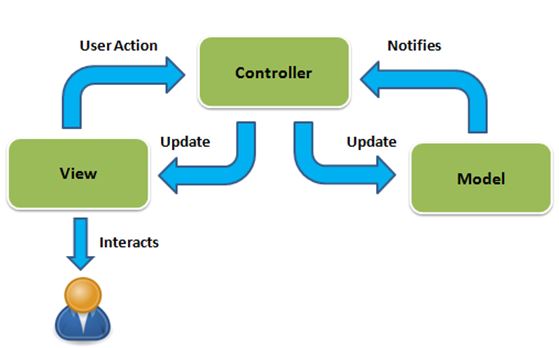The Model-View-Controller Design Pattern
Web Applications Architectures
Early web application architectures did not have much organization on the server side:
- – Primarily fetching static web pages.
- – No separation of data from its presentation.
- – As applications became richer, server-side scripts became more complicated, and the applications became very difficult to maintain.
The Model-View-Controller (MVC) architectural design pattern, implemented over the middleware, is used in many web application frameworks and was introduced as a means of dealing with this complexity:
- – Decouples data (model) and presentation (view).
- – A controller handles requests, and coordinates between the model and the view.
- – More robust applications, easier to maintain.
The MVC Design Pattern
The MVC design pattern is an architecture-level design pattern that is actually a collection of design patterns:

- Model – The domain-specific representation of the data over which the application operates, with domain logic that adds “meaning” to raw data. A database is often used to store the data.
- View – Renders the model in a view suitable for interaction, typically via a user interface. Multiple views can be created for a single model, each serving different purposes.
- Controller – Mediates between the model and the view. Responsible for the action taken by the user on the View component.
Although there are different varieties of MVC, the control flow is generally:
- The user interacts with the user interface in some way (for example, by pressing a button).
- The controller handles the input event from the user interface, often via a registered handler or callback, and converts the event into an appropriate user action, understandable for the model.
- The controller notifies the model of the user action, possibly resulting in a change in the model’s state. E.g., the controller may update the user’s account information.
- A view queries the model in order to generate an appropriate user interface (e.g., the user’s account information). The view gets its own data from the model. In some implementations, the controller may issue an instruction to the view to render itself. In others, the view is automatically notified by the model of changes in state (Observer design pattern) that require a screen update.
- The user interface waits for further user interactions, which restarts the control flow cycle.
Latest Post
- Dependency injection
- Directives and Pipes
- Data binding
- HTTP Get vs. Post
- Node.js is everywhere
- MongoDB root user
- Combine JavaScript and CSS
- Inline Small JavaScript and CSS
- Minify JavaScript and CSS
- Defer Parsing of JavaScript
- Prefer Async Script Loading
- Components, Bootstrap and DOM
- What is HEAD in git?
- Show the changes in Git.
- What is AngularJS 2?
- Confidence Interval for a Population Mean
- Accuracy vs. Precision
- Sampling Distribution
- Working with the Normal Distribution
- Standardized score - Z score
- Percentile
- Evaluating the Normal Distribution
- What is Nodejs? Advantages and disadvantage?
- How do I debug Nodejs applications?
- Sync directory search using fs.readdirSync